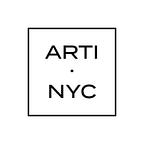By Daria Pletneva
Today’s “contemporary” is so much different from the post-war “contemporary,” and it is becoming harder to explain what period are you referring to. Isn’t it time for the new term? “Modern” had to get outdated at some point even though the word itself means nothing but up-to-date, so “contemporary” should also remain history. The term we use at the gallery for our convenience is “UX art,” where UX stands for User Experience. So why does the UX is the new Renaissance?
1) The connection between art and science.
The first characteristic of the bright end of the Medieval age is the inseparable connection of art with flourishing science, like now, in 2019. Artists embrace the newest technologies creating immersive art experiences across the online platforms, using the digital tools. In post-war contemporary period art aspired to simplicity.
However, today art could not be more complicated: Virtual Reality, Augmented Reality, 3D. It takes a lot of scientific knowledge and skills to design not just the artwork but the whole interactive experience.
“Your five-year-old son” could not have done this anymore. In the Renaissance, this scientific approach reduced to the anatomical accuracy of live figures and brand new topics caused by the revelation of some important philosophical texts previously unknown. Today’s scientific knowledge concerns the programming and IT. It is hard to question UX artists’ legitimacy like it was during the never-ending pop-art period.
2) New perspective.
One more attribute of the Renaissance art is linear perspective. The artists mastered the rules of perspective to achieve the documentary and photographic likeness with the reality. Today artists rethink the perspective dramatically; we no longer need to stick to a canvas to create vivid volume.
For instance, in our gallery, we represent a series of artworks in Augmented Reality by Sarah Tse. The regular paintings come with the specially designed iOS application, which recognizes the objects on the paintings and animates them in 3D while you are looking through the mobile screen. The animals walk away onto the gallery wall; all the moving objects make an impression that you can touch each of them separately from one another. At the same time, virtual reality does not make the art look real, but it tends to make you forget what reality is.
In fact, the discovery of perspective six hundred years ago triggered the development of the cross-genre virtual reality techniques today.
3) 3D
Also, it was the artists of Renaissance who started using a high contrast between light and dark to give the illusion of depth or three-dimensionality.
So basically Michelangelo and his fellow artists created the first prototype of modern 3D.
4) New understanding of the Universe.
And finally, if we are talking about how today is similar to the Renaissance, just thinks about this. Circa 1514 Nicolaus Copernicus first introduced his theory that the Earth spins around the Sun rather than Sun around the Earth, the structure of the Universe, which we don’t even question today. Last year Elon Musk first submitted his conjecture that the whole World is the matrix and there is no evidence of the opposite. Once again the dramatically unexpected understanding of the Universe which is still hard to believe.
UX in the Art Market.
As a part of the global matrix, the art world is in the avant-garde of user experience. Art professionals momentarily apply the newest trends into their business routine. The leading galleries have been in the process of convergence over the past few years, building their presence online. For instance, Saatchi is now positioning itself as “World’s #1 Museum on Social Media.” Together with the other popular art platforms like Artsy and Paddle 8, they have grown the habit of discovering and buying art online. But there are still some untilled fields left for the art market.
At the beginning of 2017 ARTI.NYC became the first full-service gallery on Apple TV. As the art market has previously succeeded in adopting e-commerce, online auctions, Instagram, and app store, the art streaming channel on Apple TV is a brand new experience. It was designed for entertainment, creating beautiful artistic atmosphere and vibrant backgrounds as much as for marketing the original art to collectors.
We are happy to experiment with what the UX Renaissance bring us.
